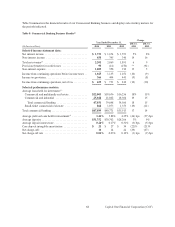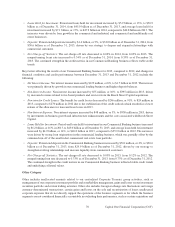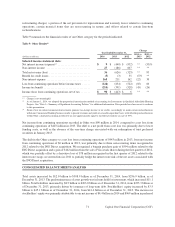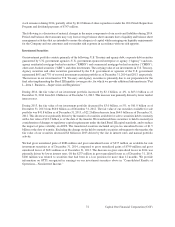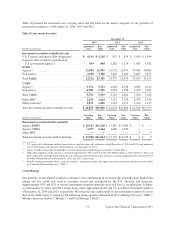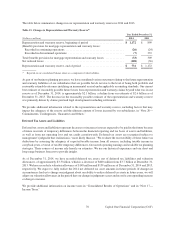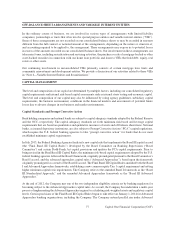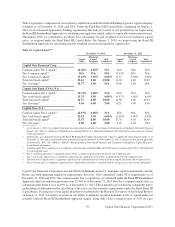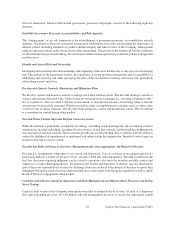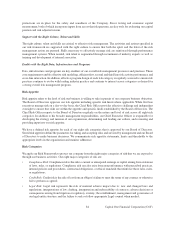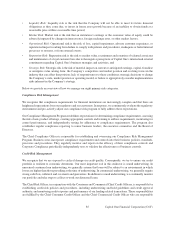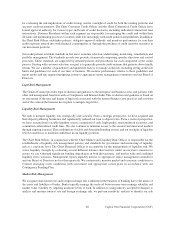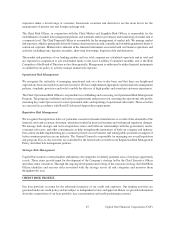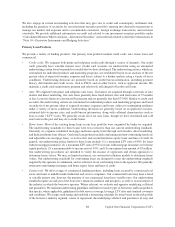Capital One 2014 Annual Report Download - page 100
Download and view the complete annual report
Please find page 100 of the 2014 Capital One annual report below. You can navigate through the pages in the report by either clicking on the pages listed below, or by using the keyword search tool below to find specific information within the annual report.Approaches on January 1, 2015, during which it will calculate capital ratios under both the Basel III Standardized
Approach and the Basel III Advanced Approaches, though it will continue to use the Basel III Standardized Approach
for purposes of meeting regulatory capital requirements. By rule, the parallel run must last at least four consecutive
quarters. Therefore, the first quarter of 2016 is the earliest possible date on which the Company would use the Basel
III Advanced Approaches framework in calculating its regulatory capital and risk-weighted assets for purposes of
risk-based capital requirements. Consistent with the experience of other U.S. banks, it is possible that our parallel
run will last longer than the four quarter minimum. Under the Dodd-Frank Act and the Final Basel III Capital Rules,
organizations subject to Basel III Advanced Approaches may not hold less capital than would be required under the
Basel III Standardized Approach. Therefore, even after we exit parallel run, we will continue to calculate regulatory
capital and risk-weighted assets under the Basel III Standardized Approach.
As of January 1, 2014, the new minimum risk-based and leverage capital requirements for Advanced Approaches
banking organizations include a common equity Tier 1 capital ratio of at least 4.0%, a Tier 1 risk-based capital ratio
of at least 5.5%, a total risk-based capital ratio of at least 8.0%, and a Tier 1 leverage capital ratio of at least 4.0%.
On January 1, 2015, the minimum risk-based capital ratio requirements increased to 4.5% for the common equity
Tier 1 capital ratio and to 6.0% for the Tier 1 risk-based capital ratio. The minimum requirements for the total risk-
based capital ratio and the Tier 1 leverage capital ratio did not change from 2014 to 2015.
The Final Basel III Capital Rules also introduced a new supplementary leverage ratio of 3.0% for all Advanced
Approaches banking organizations. On September 3, 2014 the Federal Banking Agencies issued a final rule that
revised the calculation of total leverage exposures and implemented the supplementary leverage ratio. The
supplementary leverage ratio compares Tier 1 capital to total leverage exposures, and includes all on-balance sheet
assets and many off-balance sheet assets, including derivatives and unused commitments. The new supplementary
leverage ratio becomes effective on January 1, 2018, however as an Advanced Approaches banking organization,
we are required to calculate and publicly disclose our supplementary leverage ratio beginning in the first quarter of
2015.
Insured depository institutions are also subject to PCA capital regulations. Under current PCA regulations, an
insured depository institution is considered to be well-capitalized if it maintains a Tier 1 risk-based capital ratio
of at least 6.0%, a total risk-based capital ratio of at least 10.0%, a Tier 1 leverage capital ratio of at least 5.0%,
and is not subject to any written agreement, order, capital directive, or PCA directive issued by its regulator.
While the Final Basel III Capital Rules increased some of the thresholds for the PCA capital categories and add
the new common equity Tier 1 capital ratio to the PCA regulations, those changes are not effective until
January 1, 2015. Beginning on January 1, 2015, the well-capitalized level for the Tier 1 risk-based capital ratio
will increase to 8.0%, and the well-capitalized level for the common equity Tier 1 capital ratio will be established
at 6.5%. The well-capitalized levels for the total risk-based capital ratio and the Tier 1 leverage capital ratio
will not change.
Prior to 2014, we also disclosed a Tier 1 common capital ratio for our bank holding company, which is a regulatory
capital measure widely used by investors, analysts, rating agencies and bank regulatory agencies to assess the capital
position of financial services companies. There was no mandated minimum or well-capitalized standard for the Tier
1 common capital ratio.
We disclose a non-GAAP TCE ratio in “Part II—Item 6. Summary of Selected Financial Data.” While the TCE ratio
is a capital measure widely used by investors, analysts, rating agencies, and bank regulatory agencies to assess the
capital position of financial services companies, it may not be comparable to similarly titled measures reported by
other companies. We provide information on the calculation of this ratio in “MD&A—Table F—Reconciliation of
Non-GAAP Measures and Calculation of Regulatory Capital Measures.”
78 Capital One Financial Corporation (COF)


